Wave-locked 914 nm laser diode in-band pumped Nd:YVO4 /LBO A-O Q switched green laser
Abstract We report a wavelength-locked 914 nm laser diode in-band pumped intra cavity efficient green laser, in our experiment, a wave-locked 914 nm laser diode was used as a pumping source, which improve pump uniformity and pump efficiency and reducing the thermal effect of the laser greatly, thus, a high beam quality 532 nm laser output is obtained. When the pump power is 18 W and the repitition rate is 130 kHz, a green laser output of 6.7 W is obtained, and the conversion efficiency is 37.2% for pumping power of 18 W, which corresponds to a conversion efficiency of 60% for absorbed pumping.
Keywords: Wave-locked; Nd:YVO4; In-band pumping;frequency doubling; 532 nm
OCIS Codes:140.3460;140.3480;140.3515;140.3540;140.3580
1 Introduction
Thermal effect is one of the most important factors hindering the further improvement of the performance of solid-state lasers. Severe thermal effects can lead to deterioration of the beam quality of the laser, thermal saturation and even thermal cracking of the crystal [1]. In recent years, people have been looking for ways to reduce the thermal effect of the laser. At present, the most effective method is to use resonant pumping technology, In-band pumping, which uses pump light of a specific wavelength to directly pump the ground state atoms to the upper level of the laser, instead of Pumping to a higher excited state and then relaxing through the non-radiative transition to the pumping level of the laser, the resonant pumping method eliminates the non-radiative transition from the excited state to the upper level of the laser, effectively reducing the pump The quantum loss between the puddle and the oscillating light reduces heat generation and improves quantum efficiency. It can fundamentally solve the thermal effect of the laser, thus effectively improving the performance of the laser. For the Nd:YVO4 laser resonant pump Pu mainly concentrated on three pump wavelengths of 880nm, 888nm and 914nm [2–7], theoretically and experimentally proved that Resonant pumping technology can achieve high power, high beam quality laser output, but resonant pumping technology still has many shortcomings. First, the absorption rate of crystals for these wavelengths is relatively low, especially for 914nm absorption rate. Low, which is not conducive to the improvement of the overall light-to-light conversion rate. Second, the Nd:YVO4 crystal has a narrow absorption linewidth for these wavelengths, and the semiconductor laser will shift the emission spectrum with temperature, which is not conducive to the laser. Adapt to changes in ambient temperature. In order to overcome these shortcomings, we have adopted wavelength-locked resonance pumping technology, which can effectively overcome the shortcomings of resonant pumping and further exploit the advantages of resonant pumping. The so-called lock-wavelength resonance pumping technique is to lock the emission wavelength of the pump source with a volume Bragg grating (VBG), so that its emission wavelength tends to be stable, and the change of the external environment temperature has little influence on its emission spectrum. At the same time, the pump Puyuan’s emission spectrum is narrower and more accurate, corresponding to the absorption spectrum of the working substance. In combination with the above aspects, the locked-wavelength resonant pumping technique has obvious advantages over the ordinary resonant pumping technology.
At present, there are not many researches on 914nm resonant pumping technology, and basically use non-locking wavelength semiconductor lasers or 914nm lasers generated by solid-state lasers as pump sources. In 2009, Damien Sangla et al reported using 914nm pumped Nd. : YVO4 crystal laser, when absorbing 14.8W of pump light power, obtained 11.5W of 1064nm laser input
The corresponding light-to-light conversion rate of the absorbed pump light is 78.7%, and the slope efficiency is 80.7% [8]. In 2013, Chen et al. used 914nm as the pump source of the regenerative amplifier to reduce the heat load and achieve high The performance of the regenerative amplifier, and 1nJ, pulse width 5.7ps, frequency 42.7MHz seed regenerative amplification, and finally get 100kHz, 21.2W regenerative amplification output [9], the same year Ding Xin et al. using end-pumped 914nm solid The laser is used as a pump source to pump Nd:YVO4. The 20mm long, doped 2% Nd:YVO4 is used as the gain medium, and the 3.92W 1064nm laser output is obtained at 6.9W injection pumping power. — The light conversion efficiency is 56.9% [10]. In 2016, Tanant Waritanant et al. used the 914nm pumped Nd:YVO4 to achieve mode-locked laser output, and obtained a 6.7W, 87MHz mode-locked laser output, corresponding to the absorption of pump light. The slope efficiency is 77.1%, and the light-to-light conversion efficiency is 60.7% [11]. The above studies all use ordinary semiconductor lasers or solid-state lasers with non-locking wavelengths as pump sources, and all of them are for the study of fundamental frequency light. In the case of a semiconductor laser as a pump source, since the emission line width of the semiconductor laser is wide and the emission wavelength shifts with temperature, the absorption efficiency of Nd:YVO4 to 914 nm pump light is low, resulting in overall light. The light conversion efficiency is not high, much lower than the traditional 808nm pumping method, and the use of the 914nm solid-state laser as the pump source adds complexity and cost to the system.
In order to overcome the shortcomings of 914nm resonant pumping and take advantage of the 914nm resonant pumping technology, this paper first applied the locked-wavelength 914nm resonant pumping technique to the Nd:YVO4 intracavity frequency doubled laser, using the pump source as the center wavelength.
A 913.9nm lock-wavelength fiber-coupled-output semiconductor laser with a linewidth of 0.3nm, using an acousto-optic Q-switch as a modulator, and a Class I critical phase-matched LBO as a frequency-doubled crystal for high-frequency, high-beam The mass of 532nm laser output, when the incident pump power is 18W and the modulation frequency is 130kHz, the highest 6.7W 532nm green light output is obtained, and the overall light-to-light conversion rate is 37.2%, corresponding to the light-to-light conversion efficiency of the absorbed pump light. With 60% pulse width and 52 ns, the experimental results show that the overall light-to-light conversion efficiency can be compared with the traditional 808nm pumping method, and this method can effectively reduce the thermal effect of the laser and improve the beam quality of the output laser.
2. Experimental device
The experimental device shown in Figure 1 is a 914nm wavelength-locked fiber-coupled semiconductor laser with a maximum output power of 20W and a linewidth of 0.3nm. This narrow linewidth can be well matched to the absorption bandwidth of the crystal. The resonance pump has the disadvantage of narrow absorption band, and the pump source has good temperature stability. When the heat sink temperature is changed from 10 °C to 40 °C, the center wavelength of the emission is only moved by 0.6 nm, and the line width is basically maintained. This does not change, which makes the use of the semiconductor laser as a pump source with extremely high temperature stability. The transmission fiber has a diameter of 400μm and a numerical aperture of 0.22. The Coupler is an optical coupling system. After the coupling system, the pump spot diameter is about ~700μm, M1 is plated with a 1064nm high-reflection film, and the laser crystal size is 3×3×20mm 3,1. % doped, crystals are wrapped in indium foil and placed in a copper heat sink. M2 is plated with 914nm anti-reflection and 1064nm high-reaction film system, M3 plated with 532nm anti-reflection and 1064nm high-reaction film system, M4 plated with 1064nm and 532nm
High-reaction film system, AO is acousto-optic Q switch, its ultrasonic frequency is 80MHz, RF power is 20W, double-sided coated with 1064nm anti-reflection film, LBO is 3x3x15mm, Class I critical phase matching method, cutting angle is θ=90 °, φ=11.2°, placed in a high-precision temperature control box with a temperature control accuracy of ±0.03 °C, coated with 1064nm and 532nm anti-reflection coatings at both ends, and the distance from the right end of M1 to Nd:YVO4 is 100mm, M2 to The distance from the left end of Nd:YVO4 is 20mm, and the distance from M2 to M3 is 80mm.
The distance from M3 to M4 is 40mm, and M1, M2, M3, and M4 are flat mirrors.
Fig 1 setup and light path of wavelength-locked laser diode in-band pumped Nd:YVO4 /LBO green laser
Figure 2 shows the spot size distribution in the cavity. It can be seen from the calculation results that the fundamental mode spot diameter on the Nd:YVO4 crystal is 624μm, which has a good pattern matching with the 700μm pump light. In addition, it is larger. The pump spot can further reduce thermal effects while reducing the up-conversion effect of highly doped Nd:YVO4 crystals.
3. Analysis of results
First, we tested the absorption of pump light by Nd:YVO4. When the crystal heat sink temperature is 25 °C, 1% doping,
The 20mm long Nd:YVO4 absorbs 62% of the 914nm pump light. Figure 3 shows the relationship between the output 532nm laser power and the incident pump power at different modulation frequencies. It can be seen from the experimental results that when the pump power is 18W and the modulation frequency is 130kHz, a 532nm laser output of up to 6.7W can be obtained, corresponding to the light-to-light conversion rate of the incident pump light.
37.2%, the light-to-light conversion rate corresponding to the absorbed pump light is 60%, and the modulation frequency is 170 kHz, the green light output of 5.7W is obtained, and the light-to-light conversion efficiency corresponding to the incident pump light is 31.7%, when the frequency is gradually increased from 130 kHz. When the output is reduced, the output power and conversion efficiency are gradually reduced. When the modulation is 90 kHz, 50 kHz and 20 kHz, respectively, the maximum gain is 5.8 W.
The laser output of 5.2W and 3.2W, the corresponding light and light conversion efficiencies are 32.2%, 26% and 17.7%, respectively. It can be seen that the Nd:YVO4 intracavity frequency doubling laser pumped at 914nm is able to operate at high repetition rate. A relatively high conversion efficiency is obtained. For a case where the repetition frequency is relatively low, especially at a frequency of 20 kHz, the output power will have a similar thermal saturation effect as the pump power increases. After the pump power exceeds 14 W, the output power is The slope is obviously declining. Our analysis is mainly because the high-doping concentration crystal is more serious when the inverter is running at low frequency, because the up-conversion rate can be written as gDn2.
Where is the up-conversion coefficient, Dn is the inverse particle number density [12–16], from which we can see that the up-conversion rate is proportional to the square of the inverse particle number density, especially in the high When the doping concentration crystal is operated at a low frequency and the pump power is high, the number density of the inverted particles is high at this time, and the up-conversion and fluorescence quenching effects are further enhanced, so that the light-to-light conversion rate is significantly lowered.
Fig 4 Relationship between output power , efficiency and repetition frequency at pump power of 18W
Figure 4 shows the output power, light-to-light conversion efficiency (corresponding to absorbed pump power) and repetition frequency for 18W pump power.
Relationship, it can be seen from the experimental results that when the repetition frequency is gradually increased from 40 kHz to 130 kHz, the output power is also increased, and the light-to-light conversion efficiency is also slowly increased. When the repetition frequency is 130 kHz, the output power is up to 6.7 W. When the frequency is gradually increased from 130kHz to 170kHz, the output power decreases. When the modulation frequency is 170kHz, the output power drops to 5.7W, but the output power and light-to-light conversion efficiency of the above two processes are slowly changing, but when When the repetition frequency is reduced from 30 kHz to 15 kHz, both the output power and the light-to-light conversion efficiency drop sharply. Experimental results show that this
The 914nm resonant pumped high-doped Nd:YVO4 laser is more suitable for operation at high repetition frequency. When the repetition frequency is too low, the high-doped crystal has a short upper energy level lifetime and a high up-conversion coefficient, which leads to strong spontaneous emission. And upconversion loss.
The experimental measurement shows that the pulse width is 52 ns at a pulse frequency of 130 kHz, and the corresponding peak power is 1 kW. We measure the beam quality of the laser with a knife edge (90/10), and obtain the beam quality factor of the green light in the X direction and the Y direction. The results are 1.3 and 1.2, respectively. The measurement results are shown in Figure 5. The reason why the better beam quality output can be obtained is mainly because: First, the 914nm pump reduces the heat generated by the quantum loss, thereby reducing the thermal lens effect. The beam quality is improved; secondly, reasonable pattern matching is also an important reason for obtaining good beam quality.
Fig 5 Beam quality factor measurement results
4. Conclusion
For the first time, the 914nm resonant pumping technology is applied to the acousto-optic Q-switched intracavity frequency doubling laser. In the experiment, Nd:YVO4 is used as the gain medium, and the class I critical phase matching LBO is used as the frequency doubling crystal. High repetition rate, high beam quality 532nm laser output. The laser has good performance at high repetition frequency. When the repetition frequency is low (❤0kHz), the doping concentration of Nd:YVO4 is high, especially when high power pumping is up-converted and spontaneous emission is compared. Serious, it will lead to a significant decline in light and light conversion efficiency. When the pump power is 18W and the repetition frequency is 130kHz, the multiplier light output of up to 6.7W is obtained, the light-to-light conversion rate corresponding to the incident pump light is 37.2%, and the light-to-light conversion rate corresponding to the absorbed pump light is 60%. The conversion efficiency can reach the level compared with the traditional 808nm pumping method, and has a good application prospect.
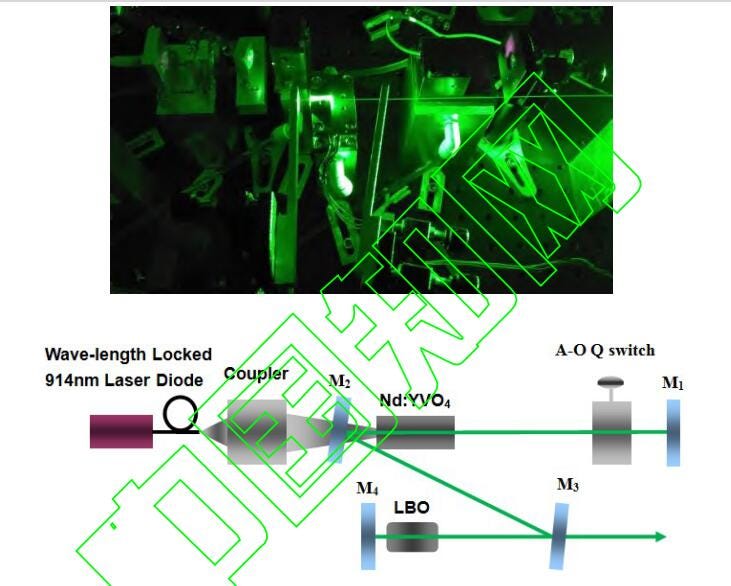
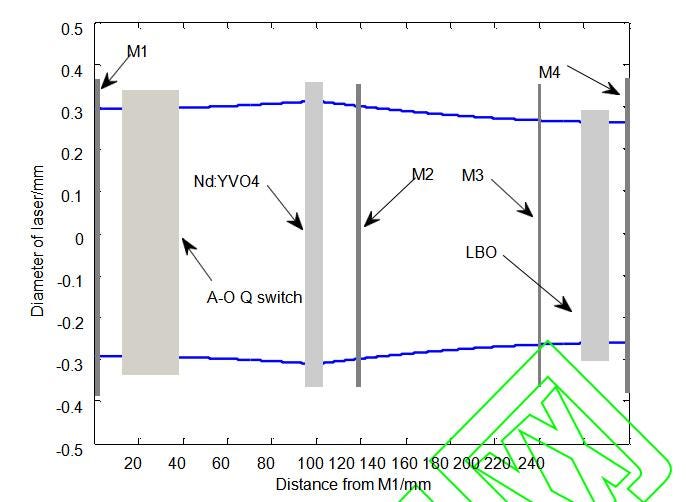
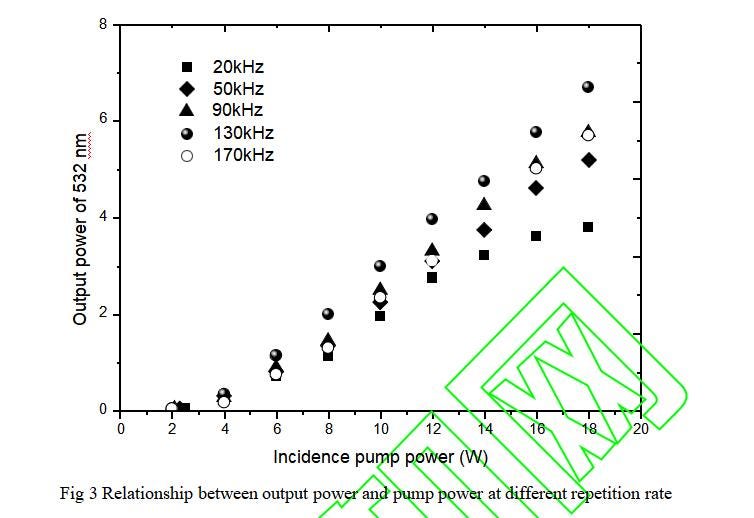
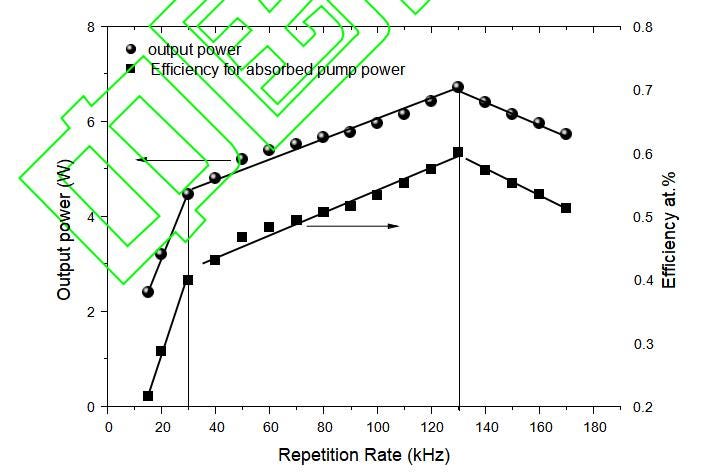
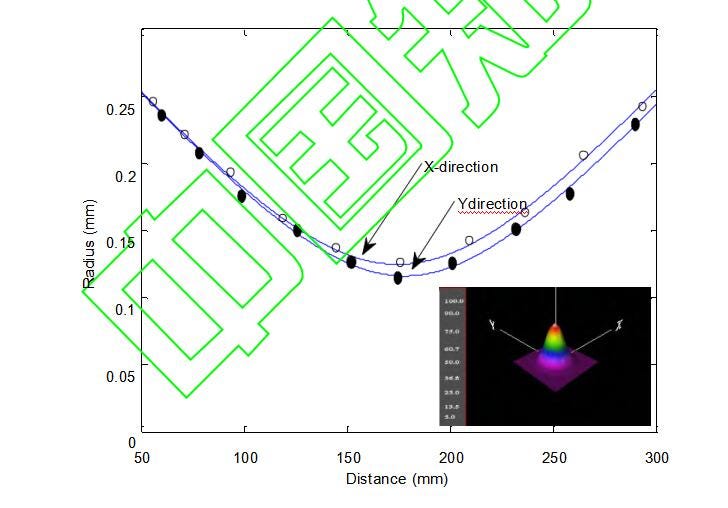
Comments
Post a Comment